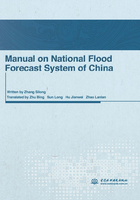
Introduction
After late 1980s,with the popularity and evolution of computer technology,various flood forecasting softwares were developed respectively by hydrological information and forecasting sectors at different levels in China.However,owing to lack of integrated management,these locally developed software programs introduced three major problems into flood forecasting.First,these independent softwares were developed according to specific requirements and objectives.With the hydro-climatic variations in China from humid to arid conditions,there was no flood forecast system which can consider all hydro-climatic features needed for modeling river flow in the different hydro-meteorological regimes.Second,these softwares had a rigid program structure which made it difficult to add new modules as additional features were developed.The hydrological modeling structure required that all basins use the same models in a fixed sequence.Third,the softwares were dependent on the individual who carried out the initial development.When this person changes jobs or retired,much of the knowledge on how to run the programs,or how to maintain or enhance the programs is lost.Hence,until 1998 there was no a uniform flood forecast system to be developed and applied in China.
After 1998's disastrous flood in Yangtze River,Songhua River and Pearl River,NFFS has been designed,developed,tested and implemented by BOH of MWR associated with related universities and scientific research academies.Based on the existing status of hydrological information and forecasting in China,NFFS has been developed in Client/Server structures,relying on the uniform real time hydrological information database and GIS platform.It adopts the standardized and advanced software and hardware environment with modular and opening structure to easily add new models and procedures.It possesses the common forecasting models and method library to promptly build forecasting schemes.It has the functions of model parameters calibration that combines manual error-trial and automatic optimization methods.Therefore,the user can intervene in any real time forecasting processing through interactive forecasting by using the graphical and tabular interface.Additional,NFFS has the powerful function of analysis and performance to compare the results of multi-models and multi-schemes.Thus,NFFS can efficiently process large amounts of hydrological data to produce forecasts at hundreds or thousands of locations as a uniform and integrated as well as facile national real time flood forecasting operational system.
So far,the NFFS has been extended and applied by flood forecasting sectors in 31 provinces and 7 large river basin authorities as well as 224 local hydrological services in China.Hence,it has improved significantly the modernization level of flood forecasting in whole country and reduced local flood losses,and brought eminent economic and social benefit in recent years.